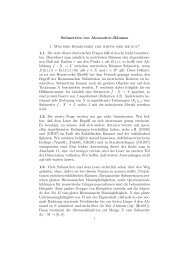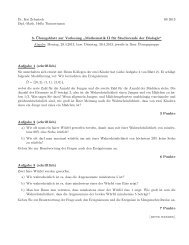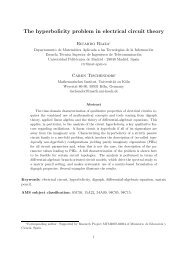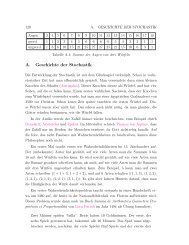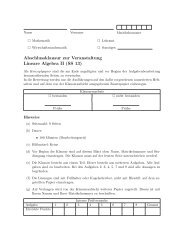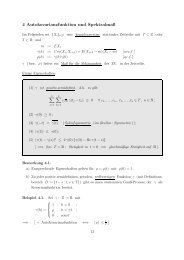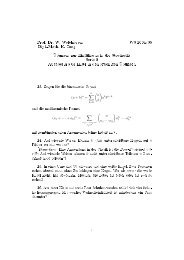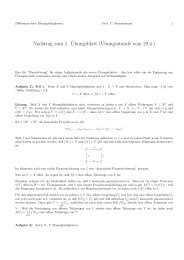Inhaltsverzeichnis - Mathematisches Institut der Universität zu Köln
Inhaltsverzeichnis - Mathematisches Institut der Universität zu Köln
Inhaltsverzeichnis - Mathematisches Institut der Universität zu Köln
Create successful ePaper yourself
Turn your PDF publications into a flip-book with our unique Google optimized e-Paper software.
DMV Tagung 2011 - <strong>Köln</strong>, 19. - 22. September<br />
Oleksandr Kutovyi<br />
Bielefeld <strong>Universität</strong><br />
Markov Jump Dynamics in Continuum: State Evolution and Vlasov Scaling<br />
We investigate a stochastic (conservative) jump dynamics of interacting particles in continuum. We<br />
consi<strong>der</strong> objects dual to correlation functions (respectively correlation measures), which are called quasiobservables.<br />
By solving the evolution equation for quasi-observables, we obtain the non-equilibrium<br />
evolution of these objects. The corresponding dual equation describes the time evolution of correlation<br />
functions and generalizes the BBGKY-hierarchy from Hamiltonian to jump dynamics. By means of the<br />
duality between quasi-observables and correlation functions we can transfer the evolution of quasiobservables<br />
to correlation functions. Afterwards we perform a Vlasov-type scaling of the dynamics, which<br />
leads to a rescaled and limiting evolution of correlation functions. We show convergence of the solution of<br />
the rescaled hierarchy to the solution of the limiting one. The chaos preservation property of the limiting<br />
hierarchy leads to the <strong>der</strong>ivation of a kinetic equation for the particle density which is a Vlasov-type<br />
equation for the consi<strong>der</strong>ed model.<br />
Eugene Lytvynov<br />
Swansea University<br />
Determinantal point processes with J-Hermitian correlation kernels<br />
Let X be a locally compact Polish space. The configuration space over X, denoted by Γ, is defined as the<br />
set of all locally finite subsets of X. A probability measure on Γ is called a point process. A point process<br />
µ can be described with the help of correlation functions: the n-th correlation function is a non-negative<br />
symmetric function k (n) (x1,...,xn) on X n which may be heuristically interpreted as the µ-probability to<br />
find points x1,...,xn in a configuration. A point process is called determinantal if there exists a function<br />
K(x,y) on X 2 , called the correlation kernel, such that the n-th correlation function of this point process<br />
is given by det[K(xi,xj)] n i, j=1 . If the correlation kernel is Hermitian, the Macchi–Soshnikov theorem gives<br />
a necessary and sufficient condition for the existence of a determinantal point process with correlation<br />
kernel K(x,y). We will <strong>der</strong>ive a counterpart of this theorem in the case where the correlation kernel is<br />
J-Hermitian, i.e., Hermitian in an indefinite scalar product. Such point processes occurred in Borodin and<br />
Olshanski’s studies on harmonic analysis of the infinite symmetric group.<br />
Maria João Oliveira<br />
Universidade Aberta/CMAF<br />
Glauber dynamics in the continuum via generating functionals evolution<br />
We construct the time evolution of Glauber dynamics for a continuous infinite particle system in terms of<br />
generating functionals. This is carried out by Peano-type approximations in a scale of Banach spaces,<br />
leading to a local (in time) solution which may be extended to a global one. An application of this approach<br />
to Vlasov-type scaling in generating functionals is consi<strong>der</strong>ed as well.<br />
213




